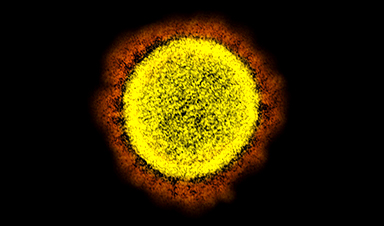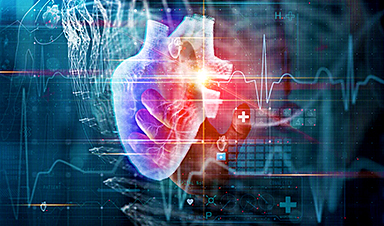The genome of the SARS-CoV-2 virus encodes 29 proteins, one of which is an ion channel called E. This channel, which transports protons and calcium ions, induces infected cells to launch an inflammatory response that damages tissues and contributes to the symptoms of COVID-19.
“The E channel is an antiviral drug target. If you can stop the channel from sending calcium into the cytoplasm, then you have a way to reduce the cytotoxic effects of the virus,” says Mei Hong, an MIT professor of chemistry and the senior author of the study.
MIT postdoc Joao Medeiros-Silva is the lead author of the study, which appears in Science Advances. MIT postdocs Aurelio Dregni and Pu Duan and graduate student Noah Somberg are also authors of the paper.
Open and closed
Hong has extensive experience in studying the structures of proteins that are embedded in cell membranes, so when the COVID-19 pandemic began in 2020, she turned her attention to the coronavirus E channel.
When SARS-CoV-2 infects cells, the E channel embeds itself inside the membrane that surrounds a cellular organelle called the ER-Golgi intermediate compartment (ERGIC). The ERGIC interior has a high concentration of protons and calcium ions, which the E channel transports out of ERGIC and into the cell cytoplasm. That influx of protons and calcium leads to the formation of multiprotein complexes called inflammasomes, which induce inflammation.
To study membrane-embedded proteins such as ion channels, Hong has developed techniques that use nuclear magnetic resonance (NMR) spectroscopy to reveal the atomic-level structures of those proteins. In previous work, her lab used these techniques to discover the structure of an influenza protein known as the M2 proton channel, which, like the coronavirus E protein, consists of a bundle of several helical proteins.
Early in the pandemic, Hong’s lab used NMR to analyze the structure of the coronavirus E channel at neutral pH. The resulting structure, reported in 2020, consisted of five helices tightly bundled together in what appeared to be the closed state of the channel.
“By 2020, we had matured all the NMR technologies to solve the structure of this kind of alpha-helical bundles in the membrane, so we were able to solve the closed E structure in about six months,” Hong says.
Once they established the closed structure, the researchers set out to determine the structure of the open state of the channel. To induce the channel to take the open conformation, the researchers exposed it to a more acidic environment, along with higher calcium ion levels. They found that under these conditions, the top opening of the channel (the part that would extend into the ERGIC) became wider and coated with water molecules. That coating of water makes the channel more inviting for ions to enter.
That pore opening also contains amino acids with hydrophilic side chains that dangle from the channel and help to attract positively charged ions.
The researchers also found that while the closed channel has a very narrow opening at the top and a broader opening at the bottom, the open state is the opposite: broader at the top and narrower at the bottom. The opening at the bottom also contains hydrophilic amino acids that help draw ions through a narrow “hydrophobic gate” in the middle of the channel, allowing the ions to eventually exit into the cytoplasm.
Near the hydrophobic gate, the researchers also discovered a tight “belt,” which consists of three copies of phenylalanine, an amino acid with an aromatic side chain. Depending on how these phenylalanines are arranged, the side chains can either extend into the channel to block it or swing open to allow ions to pass through.
“We think the side chain conformation of these three regularly spaced phenylalanine residues plays an important role in regulating the closed and open state,” Hong says.
Viral targeting
Previous research has shown that when SARS-CoV-2 viruses are mutated so that they don’t produce the E channel, the viruses generate much less inflammation and cause less damage to host cells.
Working with collaborators at the University of California at San Francisco, Hong is now developing molecules that could bind to the E channel and prevent ions from traveling through it, in hopes of generating antiviral drugs that would reduce the inflammation produced by SARS-CoV-2.
Her lab is also planning to investigate how mutations in subsequent variants of SARS-CoV-2 might affect the structure and function of the E channel. In the omicron variant, one of the hydrophilic, or polar, amino acids found in the pore opening is mutated to a hydrophobic amino acid called isoleucine.
“The E variant in omicron is something we want to study next,” Hong says. “We can make a mutant and see how disruption of that polar network changes the structural and dynamical aspect of this protein.”
News
This Tiny Cellular Gate Could Be the Key to Curing Cancer – And Regrowing Hair
After more than five decades of mystery, scientists have finally unveiled the detailed structure and function of a long-theorized molecular machine in our mitochondria — the mitochondrial pyruvate carrier. This microscopic gatekeeper controls how [...]
Unlocking Vision’s Secrets: Researchers Reveal 3D Structure of Key Eye Protein
Researchers have uncovered the 3D structure of RBP3, a key protein in vision, revealing how it transports retinoids and fatty acids and how its dysfunction may lead to retinal diseases. Proteins play a critical [...]
5 Key Facts About Nanoplastics and How They Affect the Human Body
Nanoplastics are typically defined as plastic particles smaller than 1000 nanometers. These particles are increasingly being detected in human tissues: they can bypass biological barriers, accumulate in organs, and may influence health in ways [...]
Measles Is Back: Doctors Warn of Dangerous Surge Across the U.S.
Parents are encouraged to contact their pediatrician if their child has been exposed to measles or is showing symptoms. Pediatric infectious disease experts are emphasizing the critical importance of measles vaccination, as the highly [...]
AI at the Speed of Light: How Silicon Photonics Are Reinventing Hardware
A cutting-edge AI acceleration platform powered by light rather than electricity could revolutionize how AI is trained and deployed. Using photonic integrated circuits made from advanced III-V semiconductors, researchers have developed a system that vastly [...]
A Grain of Brain, 523 Million Synapses, Most Complicated Neuroscience Experiment Ever Attempted
A team of over 150 scientists has achieved what once seemed impossible: a complete wiring and activity map of a tiny section of a mammalian brain. This feat, part of the MICrONS Project, rivals [...]
The Secret “Radar” Bacteria Use To Outsmart Their Enemies
A chemical radar allows bacteria to sense and eliminate predators. Investigating how microorganisms communicate deepens our understanding of the complex ecological interactions that shape our environment is an area of key focus for the [...]
Psychologists explore ethical issues associated with human-AI relationships
It's becoming increasingly commonplace for people to develop intimate, long-term relationships with artificial intelligence (AI) technologies. At their extreme, people have "married" their AI companions in non-legally binding ceremonies, and at least two people [...]
When You Lose Weight, Where Does It Actually Go?
Most health professionals lack a clear understanding of how body fat is lost, often subscribing to misconceptions like fat converting to energy or muscle. The truth is, fat is actually broken down into carbon [...]
How Everyday Plastics Quietly Turn Into DNA-Damaging Nanoparticles
The same unique structure that makes plastic so versatile also makes it susceptible to breaking down into harmful micro- and nanoscale particles. The world is saturated with trillions of microscopic and nanoscopic plastic particles, some smaller [...]
AI Outperforms Physicians in Real-World Urgent Care Decisions, Study Finds
The study, conducted at the virtual urgent care clinic Cedars-Sinai Connect in LA, compared recommendations given in about 500 visits of adult patients with relatively common symptoms – respiratory, urinary, eye, vaginal and dental. [...]
Challenging the Big Bang: A Multi-Singularity Origin for the Universe
In a study published in the journal Classical and Quantum Gravity, Dr. Richard Lieu, a physics professor at The University of Alabama in Huntsville (UAH), which is a part of The University of Alabama System, suggests that [...]
New drug restores vision by regenerating retinal nerves
Vision is one of the most crucial human senses, yet over 300 million people worldwide are at risk of vision loss due to various retinal diseases. While recent advancements in retinal disease treatments have [...]
Shingles vaccine cuts dementia risk by 20%, new study shows
A shingles shot may do more than prevent rash — it could help shield the aging brain from dementia, according to a landmark study using real-world data from the UK. A routine vaccine could [...]
AI Predicts Sudden Cardiac Arrest Days Before It Strikes
AI can now predict deadly heart arrhythmias up to two weeks in advance, potentially transforming cardiac care. Artificial intelligence could play a key role in preventing many cases of sudden cardiac death, according to [...]
NanoApps Medical is a Top 20 Feedspot Nanotech Blog
There is an ocean of Nanotechnology news published every day. Feedspot saves us a lot of time and we recommend it. We have been using it since 2018. Feedspot is a freemium online RSS [...]





















